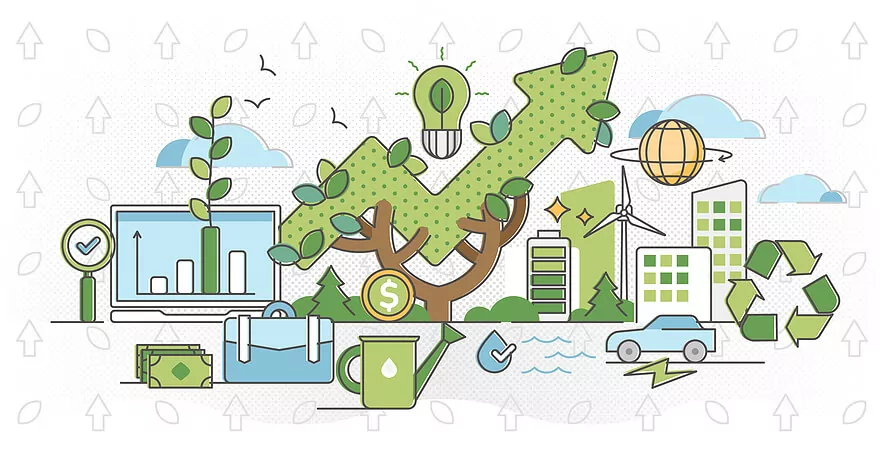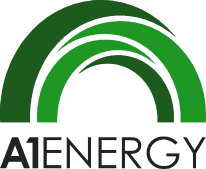
A Beginner's Guide:
Energy efficiency doesn't mean changing what you do. It means optimizing how you do it. For commercial and industrial businesses, boosting energy efficiency is a game changer for your performance indicators, sustainability goals, and—of course—your bottom line.
But what does it mean to go all in on energy efficiency? Let's dive into key factors like energy benchmarking, LED lighting financing, exterior commercial lighting, and so much more.
The Benefits of Energy Benchmarking
You can't manage what you don't measure.
That's the core of energy benchmarking. Energy management for commercial and industrial facilities requires benchmarking against peer facilities. That way, business owners can determine if they're on par with their energy usage.
Some cities even have energy benchmarking legislation to help promote corporate sustainability. Even if you're not in one of these cities, you can still reap three key benefits:
1. Benchmarking gives you a baseline. How do you improve if you don't know where you're at? Get a yearly baseline, national baseline, or compare with similar buildings.
2. You can save money by optimizing your energy. Energy Star reports that cutting energy costs by 30% is the same as increasing your net operating income by 4%.
3. Your company becomes more sustainable. According to the EPA, the industrial sector accounts for 23% of all greenhouse gas emissions. Energy management through benchmarking helps you make an impact without eating into your bottom line.
How do you get started with energy benchmarking? The Energy Star Portfolio Manager is a tool that lets you track and analyze your energy consumption across your property. You can benchmark on your own or optimize the process with the help of an energy efficiency consultant.
How Exterior Commercial Lighting Ties Into Energy Efficiency
Running outdoor lighting can be particularly inefficient if done incorrectly, especially at commercial scale.
Key factors involved in exterior commercial lighting efficiency include:
Choosing the best color temperature
For exterior lighting, warmth vs. coolness in color temperature depends on how much security you require. For example, lights between 5,000–6,000 degrees Kelvin (K) provide the most contrast and skew cooler. Display lights can get away with warmer temperatures.
Ensuring lighting is dark-sky friendly
LED area lights must be shielded with the sides pointing downwards. This is so they don't contribute to light pollution, which affects 80% of the world's population. Commercial and industrial business leaders have the responsibility of using dark-sky friendly lights, which means they're only on at necessary times and locations. In the same vein, avoid blue lights whenever possible.
Selecting the best lighting for security without compromising efficiency
This means—you guessed it—outdoor LED lighting. LED lights emit less heat than alternatives like metal halide or high-pressure sodium lamps. If you haven't gotten an LED retrofit, your energy efficiency goal is a great excuse to do so.
The Basics of LED Tubes (& Why They're a Do-It-All Option)
If you're looking to do an LED lighting retrofit, you'll want to look at LED tubes. Professionals can install direct wire LED tubes into traditionally fluorescent fixtures.
This means businesses don't require an entirely new setup. Rather, they're able to retrofit their existing lighting equipment for increased efficiency, simply by swapping fluorescent with LED tubes.
Direct wire LED tubes do not have a ballast and are designed to work directly with the power source (rather than the ballast as an electric intermediary). They take more expertise to install, but they're worth it for the average business owner.
Warehouse LED lighting is especially crucial since LED lights last longer, are more resilient, and save more money when a part of a larger network. Using LED tubes to complete your warehouse-sized retrofit is a more affordable and less wasteful way to achieve your energy efficiency goals.
How's that for a do-it-all option?
Simplified Lighting Controls Options for Energy Efficiency
Lighting controls are a way for you to master your energy usage. For many business leaders, the very idea of lighting controls feels intimidating. However, there are plenty of simplified solutions.
One example of networked lighting controls is SensorSwitch JOT. It includes built-in dimming technology without the need for any dimming wires. The software also functions with a mobile app, so you can operate how you want.
Another example is nLight AIR autonomous bridging technology, which optimizes your existing devices by connecting them to a system controller.
Networked lighting controls are getting better and better—which means it's getting easier to manage them. Plus, options like luminaire-level lighting controls (LLLC) are getting more affordable, with cost reductions as high as $90 off each luminaire for smart systems.
Image Source: Lighting Controls Association
How LED Lighting Financing Can Lead You to Efficiency
Paying for an LED lighting retrofit upfront isn't always possible. Sometimes, staying net cash-flow positive is more pressing for your business than reaching your long-term sustainability goals. But what if you could do both?
You can—thanks to LED lighting financing.
Choosing LED financing means:
- You Pay $0 in upfront costs with no payment made until the project is done.
You remain net cash-flow positive from the onset and stay liquid in case of unexpected occurrences.
Your commercial or industrial lighting ecosystem will become more resilient and sustainable.
Your monthly savings from LED energy efficiency often outweigh your monthly payments toward the financing program.
You can get financing through LED lighting consultants as well as state- or federal-level financing programs. For example, A1 Energy partners with the National Energy Improvement Fund (NEIF) for zero-cost financing.
Additionally, you can get a deal on Lighting-as-a-Service (LaaS) programs, which includes regular service and maintenance after the initial installation. This is a growing subscription-based market that more and more businesses are taking advantage of.
Check Out C-PACE Financing in Pennsylvania and Beyond
Speaking of financing, Commercial Property Assessed Clean Energy (C-PACE) helps commercial and industrial businesses finance their energy efficiency projects at a low cost in Pennsylvania and beyond.
What types of projects benefit most from C-PACE financing? There are long-term, low-cost loans (many of which cover 100% of financing) for projects falling under the following categories:
Energy efficiency equipment (including LED lighting, high-efficiency equipment, and more) Renewable energy (such as solar PV, fuel cell power, and more) Water conservation (includes anything that saves 25% or more of your water usage)
C-PACE is a program that exists in various states throughout the nation, and that list now includes Pennsylvania.
Image Source: Energy.gov
Funds like the non-profit Sustainable Energy Fund (SEF) facilitate C-PACE financing for Pennsylvanians.
Why talk about C-PACE and other financing? Because commercial and industrial business leaders need to know it's possible to take on a major energy efficiency project full speed ahead.
What to Know About EV Car Chargers In a Non-Residential Setting
Since transportation contributes 30% of all energy consumption, using plug-in hybrid (PHEV), hybrid, and all-electric (EV) vehicles helps to reduce the load. EV fleets also work to minimize imported petroleum, which bolsters the U.S. economy. With global supply chains fickle, it's a smart move for industrial businesses to pivot to car charging.
The EV sector's growth is rooted in infrastructure. Startups are everywhere supplying cloud-based networks of EV charging stations and portable backups. EV Box, ChargePoint, and SparkCharge are just a few of the companies making an imprint.
With potential federal infrastructure legislation on the horizon, the U.S. executive branch may spearhead a national network of 500,000 new charging stations. This would add to the existing 41,400 charging stations in the country.
If you search "EV charging stations near me" on Google, you find trip planning resources like PlugShare and the U.S. Department of Energy's Alternative Fueling Station Locator. Your area may already be ripe with charging stations, or things may still be developing in your region. Either way, it can give you a good idea of how saturated the network is near you, and how long it might be until there's a strong collection of charging stations that you're ready to invest in and contribute to.
Commercial and industrial businesses with EV fleets also receive incentives. For example, Pennsylvanians and residents of other states get a federal tax credit that gives their business "30% of the total cost of purchasing and installing a ChargePoint electric vehicle charging station."
There's also a Notice of Funding Opportunity (NOFO) out for transit buses and their associated acquisition, construction, and leasing of required supporting facilities. Meanwhile, the PECO Commercial Level 2 Electric Vehicle (EV) Charger Rebate offers up to $1,500 per installation.
The point?
You have a lot of options when it comes to acquiring EV charging stations for an industrial setting—and your list of options is only growing.
How Does Energy Efficiency Affect Carbon Reduction Goals?
Carbon emission reduction ties right in with a clean energy plan.
In fact, switching to a more energy efficient operation is one of the easiest ways to impact your carbon reduction goals. You can install more efficient equipment and switch where you get your energy from.
One of the key reasons it's so simple is because you're rewarded in the form of lowered energy bills pretty much immediately. Paired with financing opportunities, you've got yourself a winning tactic.
As for how much of a difference you'll see in your carbon footprint, it depends on where you currently get your energy from. For example, if you're using a high-carbon source like fossil fuels, you'll see a major difference. If you're using a low-carbon course like renewable energy, the difference will be slimmer.
However, we see the difference on a large scale. The American Council for an Energy-Efficient Economy reports a potential 57% reduction in greenhouse gas emissions and $700 billion in savings by 2050 if we take the recommended measures.
Industrial and commercial businesses account for a big chunk of energy usage in the U.S., so you can imagine how much of an impact this makes.
What's your first step toward a clean energy plan geared for carbon emission reduction? Here's an easy place to start: LEED certification.
LEED (Leadership in Energy and Environmental Design) is a rating system that you can use as a framework for energy efficiency. Not only does a LEED certification improve efficiency—it also increases your property value.
The Role of Energy Efficiency for ESG
Energy efficiency in commercial buildings is an important aspect of meeting ESG (Environmental, Social, and Governance) targets. ESG refers to the criteria that investors and stakeholders use to evaluate a company's performance in terms of environmental, social, and governance factors.
Commercial buildings are responsible for a significant portion of global energy consumption and greenhouse gas emissions, making them a key focus area for companies seeking to reduce their environmental impact and meet their ESG targets. Energy efficiency measures in commercial buildings can include upgrades to lighting, heating, ventilation, and air conditioning systems, as well as improvements in insulation and building envelope performance.
By improving energy efficiency in commercial buildings, companies can not only reduce their environmental impact but also lower their operating costs through reduced energy consumption. This can help improve their financial performance and increase their attractiveness to investors who prioritize sustainability and ESG factors.
In addition to environmental benefits, energy efficiency measures in commercial buildings can also improve the comfort and productivity of building occupants, contributing to the social aspect of ESG. Energy-efficient buildings with healthier indoor environments have been shown to improve employee health and wellbeing, leading to increased job satisfaction, productivity, and employee retention.
Overall, energy efficiency in commercial buildings is a critical aspect of meeting ESG targets, providing environmental, social, and economic benefits that can contribute to long-term business success.
FAQ On Energy Efficiency for Commercial & Industrial Buildings
- What does energy efficiency mean for business?
For commercial and industrial businesses, energy efficiency means optimizing your current operation to make it run on less energy. It doesn't mean changing what you do—just how you do it. - Why is it important to be energy efficient?
Company owners who improve their energy efficiency are able to save money, reach their sustainability goals, and pave the way for a more successful business down the line. - When is the right time to increase energy efficiency?
Various financing opportunities make it easy to start your energy efficiency journey today. The easiest way to find out what's available to you is to touch base with a consultant in your region. You'll be able to take advantage of federal tax credits, state incentives, private long-term financing, and even grant-based programs when available. Use these opportunities to your advantage.
Bottom Line on Energy Efficiency for Commercial & Industrial Businesses
Small and large businesses alike require some level of energy efficiency. Wherever you fall in the spectrum, know that all the changes you make are for the long term. Looking at basics like EV charging station incentives, C-PACE financing, Energy Star Benchmarking, and so much more help you build a blueprint for large-scale efficiency.
So where do you start? By making a plan on your own or connecting with an energy efficiency consultant in your area. Pennsylvania businesses can connect with A1 Energy to get a head start.

BONUS MATERIAL
When considering these energy efficiency tips it is important to also evaluate your commercial energy procurement strategies. Check out our 101 guide on energy procurement strategies for the modern facility.
